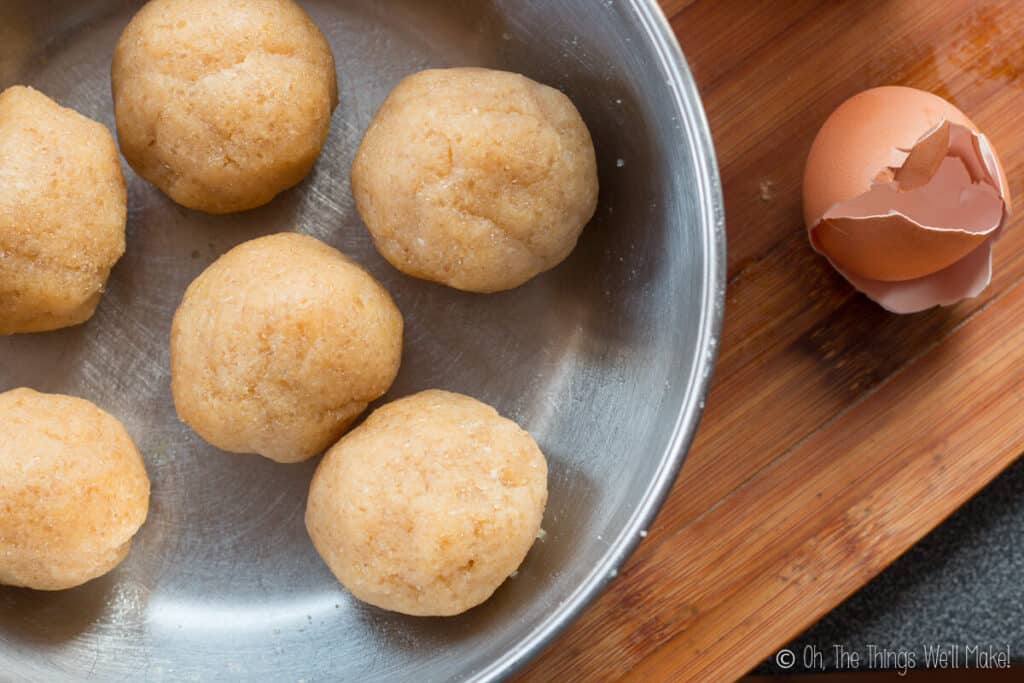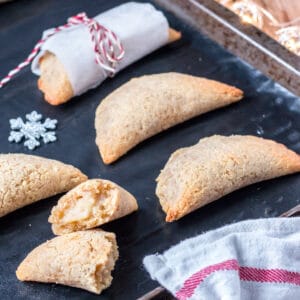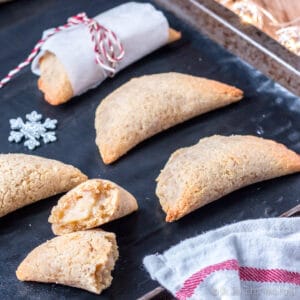The most popular Spanish Christmas pastry in my area of Spain, pastissets are a type of empanadilla that is often filled with a sweet boniato (white sweet potato) filling.
Yesterday, I shared with you how to make dulce de boniato, a Spanish pastry filling that is popular at Christmas time. It is made with boniato, a white sweet potato.
Today I am going to share a recipe for a grain-free almond pastry dough that can be used for making pastissets, the most popular Christmas pastries in my area of Spain. Pastissets are a type of sweet empanada often filled with dulce de boniato. They are also referred to as pastelitos or empanadillas dulces when speaking in Spanish. The term “pastissets” is actually the Valencian and Catalonian name for them.
Pastisset pastry types
Pastissets can be made with either a wheat flour-based dough or an almond flour-based one. While the wheat flour-based pastry is probably more commonly used, I much prefer the almond flour-based one. It isn’t just because it’s gluten-free and grain-free.
Wheat flour is probably more commonly used when making the pastries because it is a lot cheaper and a little bit easier to make. The almond flour-based pastry is more delicate, so you have to be more careful when forming your pastries, but it is definitely worth the extra effort.
Once they are made, the results are spectacular. The pastry itself is reminiscent of marzipan, which combines perfectly with the sweet boniato filling.
Ingredients
This recipe only uses a few simple ingredients. The pastry is mainly made from almond flour, an egg, sugar, and honey. You can also add a bit of cinnamon for flavor.

This recipe is an adaptation of a recipe from a friend of mine, Victoria Monera, who also has two blogs of her own. If you are looking to practice your Spanish, they might be of interest to you. She shares her recipe for the pastry dough on a blog filled with recipes, stories, and other articles. Her other blog, españolextranjeros.com, is filled with grammar exercises for those who are either studying or teaching Spanish.
My friend’s recipe uses a kilogram of almond flour. That reflects how most people here make pastissets. They get together with family and friends and make a large batch so that they can share with others. I decided to quarter her recipe to make it more practical for making in one home. When quartered, this recipe makes 6 large pastissets.
Apart from the amount used, I also changed the amount of sugar and the type of sugar used. The original recipe calls for white table sugar, but I replaced it with coconut sugar and honey. The honey adds flavor and helps make a more easily moldable dough.
You can use whatever sugar you prefer, though! Lighter sugars will result in lighter colored pastries!
Making the dough
Making the dough for pastissets is simple. Combine all of the ingredients together in a medium to large bowl, mixing them well to form a dough. This step is probably easiest using clean hands to work the dough together.
The dough may be slightly sticky at first, but should become workable as you incorporate all of the flour. If you are using a large egg and find that the moisture of the egg and honey may make the dough too sticky, adding some more almond flour should help you fix it.

Add sugar to the almond flour. 
cinnamon 
an egg 
honey 
Once you have a workable dough, divide it into six equal parts. Roll each of the parts into a ball. I find it’s easiest to work the dough if it has been chilled first, but you can make them right away, if you like. (If you are having a hard time working with the dough, though, consider placing it in the fridge for a while before continuing.

The dough next to dulce de boniato. 
Divide into six parts. 
If using white sugar, the dough will be lighter in color.
Making the pastries
Once you have the balls of dough ready, press them into flat circles that are about half a centimeter thick (just under a quarter of an inch). Pressing the dough on parchment or wax paper can help flatten the dough without it sticking.
Scoop some filling into the center of the dough circle and fold the pastry circle in half over the filling. Use the paper to help fold the dough over onto itself. Seal the edges shut.
Place the sealed pastissets onto a baking sheet lined with parchment paper.
Once you’ve filled all of the pastries, bake them until they are a light golden brown.
Other fillings
If you aren’t a fan of boniato, you can fill these almond-based pastries with other sweet fillings. Common pastisset fillings used here are almond paste and “cabello de angel,” a sweet filling made with cooked Siam pumpkin.
That said, you can really let your imagination run wild. Why not try some of your favorite pie fillings. I bet an apple filling would be delicious. (I’d try pre-cooking anything you plan on using, though.)

Serving
Pastissets are usually served after meals around Christmas time. They are often accompanied by other typical Spanish Christmas treats like mantecados, polvorones, and turrón. (I have recipes for both the soft turrón de Jijona and the hard turrón de Alicante.)
You may have noticed that almonds take center stage in Spanish Christmas treats. If you’d like to read more about other Spanish Christmas treats, check out my post about the top traditional Spanish Christmas foods.
Video

Pastissets de Boniato: Sweet Spanish Christmas Pastries
Ingredients
For the pastry dough
- 250 g almond flour
- 7 Tbsp. coconut sugar (90g) or other sugar
- 1 Tbsp. honey
- 1 egg
- 1/8 tsp. cinnamon
For the filling
- ¾ cup dulce de boniato
Instructions
- Preheat the oven to 320ºF/160ºC.
- Mix together all of the ingredients for the pastry dough in a bowl until well combined.
- Divide the dough into 6 equal parts and roll each into a golf ball-sized ball.
- Wet your hands and press the dough flat into a disc with around a half centimeter thickness. You can use a humid cloth to help press it flat, or can also use some parchment paper or a rolling pin. I found the combination of using my hands and using the parchment paper to be the easiest.
- Spoon around 2 tablespoons of dulce de boniato, or another pastry filling, into the center of the dough circle.
- Carefully fold the pastry in half over the filling and seal the edges by pressing them together.
- Place the sealed pastries on a baking tray that has been previously lined with parchment paper or that is well-greased. Bake for 10-15 minutes, until the pastry loses most of its moisture and slightly crisps. While there is no need to let them turn golden brown, their turning a light golden brown is a good indication of their doneness.
- Remove from the oven to cool and then serve.
Notes
Customizing the recipe
These can be made with any sugar of choice. White sugar will give lighter colored pastries. The honey can be substituted with either maple syrup or more sugar.Troubleshooting
- If the dough is too sticky, add more almond flour.
- If it is too dry, add a touch of water.
- If you are having a hard time forming the dough, try chilling it before shaping it again. Using parchment paper can help you form the dough without it breaking.
 Español
Español










 Dulce de Boniato – A Spanish Christmas Pastry Filling
Dulce de Boniato – A Spanish Christmas Pastry Filling
Long
Looks so yum! Wow! This is really a great blog. Thanks you.
Cherie
My grandmother made these with regular flour. She used crisco. I just haven’t mastered the dough yet because she didn’t measure anything. She also used the dough to make cookies. Just prior to baking, she would brush the tops with whisked egg whites and a dash of sugar. I think I can replicate the filling pretty well. I never knew the name of these cookies , so thank you!
Lys
Great recipe! I love that it is made with a low-carb/grain-free flour!
I can’t eat sugars, so I have to make these with powder stevia instead of honey and coconut sugar.
Any tips, for when I try to make them without those 2 ingredients?
Thanks a lot in advance!!
Tracy Ariza
Hi Lys,
Both the filling and the outer pastry are quite versatile. I don’t find either to be especially finnicky, so I don’t think you should have a problem switching out the sweetener and just adjusting to taste.
Lys
Thanks a lot for your feedback!
I made these and finally left the stevia out. So only almond meal egg and dinnamon for the dough. I guess sugar binds the almond into a pliable dough, because mine kept breaking all the time, so it was a nightmare to fold the pastissets and manipulate the dough. I ended up adding a 2nd egg, which was quite messy. The pastissets were absolutely delicious (!!), now I’m just racking my brains as to how to make my dough not break, without the sugar. What would you do, to prevent pastissets from breaking?
Thanks for this and the dulce de boniato recipes! I’m looking forward to making them again really soon (they were addictive!!).
Tracy Ariza
Hi Lys,
That’s interesting.
I think that maybe the damp cloth method might be best if you are having problems with the dough breaking apart. I’d try taking a circle of the dough and place it on the damp cloth, fill it, and then use the cloth to help guide how you close it up. Perhaps the dampness would help keep it from breaking (as well as sticking), especially since it also helps hold the dough together as you close it.
I’m not sure otherwise. I’ll have to give it a try next time without the sugar to try to gauge the difference. It’s sometimes hard to know if that’s the actual problem or if it may be something else- like even just a difference in how finely the almonds were ground.
Lys
Thank you very much for your feedback, Tracy!
I was finally able to make them again this evening and surprisingly, everything turned out fine and I didn’t need to add a 2nd egg.
I think the problem might have been the thickness of the batter: I remember I was trying to make it pretty thin, like puff pastry, and this is definitely no puff pastry dough. So this time I stuck to the 0.5 cm thickness and also used parchment paper to carefully fold the dough – that way, everything turned out great! Of course there were some cracks, but nothing major, and much easier to fold. So happy about the result! 🙂
I was also wondering if these supposed to be crunchy/crispy or more on the soft side. Mine were definitely crunchy, I found them a bit dry, so that must have been not adding the 2nd egg. But in any case, very tasty and I’ll definitely be making them again soon. This is for sure a recipe that one can make without any sweetener, it’s naturally sweet, which I love!
Tracy Ariza
Hi Lys,
I’m happy you were able to get something workable. Yes, it is a bit tricky to work with the dough if you want the pastry to be thin. Luckily, it’s a tasty pastry, so there isn’t really a need to keep it too thin as you would want to do with flour-based pastries that can detract from the flavor of the filling. 😉
I don’t think I would have described mine as crunchy, but you do want it to be slightly dry on the outside to avoid the whole thing from being soggy. (I’m not sure I’m using the right adjectives here, but doing my best. Ha!) The filling apports moisture to the pastry, so they soften out pretty soon after being made. You can definitely play with the mixture, though, to get a different texture if you prefer something softer (adding another egg or liquid of some sort) or crispier (adding oil/fat, perhaps?). The final outcome will also depend a lot on whatever filling you are using.
I hope that helps!
Nance
I am looking for a recipe for Spanish Glorias, the marzipan filled with sweet potato or yam filling. I can’t find a recipe anywhere, and I miss them!!!
Tracy Ariza
Hi Nance,
Interesting…I’ve never seen or heard of them!
Do you know what region of Spain they are from? Sweets can vary tremendously from region to region to the point that what may be the most popular sweets in one region are completely unknown in other regions.
In any case, that actually sounds very similar to this recipe. Maybe you can try it out to see if it’s similar, and switching the white sweet potato for the orange, which is what it sounds like you’re referring to?
I wish I could be of more help.
If you can tell me the region, though, I can ask around maybe. 🙂
Tracy Ariza
Actually, after a bit of online research, I found this recipe in Spanish:
http://sevilla.abc.es/gurme/recetas/pasteles-de-gloria-rellenos-de-batata/
Yes, it looks very similar to this recipe, but using the orange sweet potato instead of the white one, and with a different shape. I’ll take a better look to compare the recipes in the morning, as I was off to bed now.
Brianna @Flippin' Delicious
Such a fun holiday tradition! 🙂
Tracy Ariza
Thanks so much, Brianna! I’ll definitely be stopping by. 🙂
Raia
These sound SO delicious! I’m going to have to gather the ingredients and give them a try. 🙂 Thanks so much for sharing them!
Tracy Ariza
Thanks Raia. 🙂
Of course- I love your Savoring Saturdays!
Sarah
These look so good! I really like that there aren’t too many expensive flours too – these are totally doable with everything that I already have in my kitchen
Tracy Ariza
Thanks, Sarah!
Yes, they really are quite simple, without too many ingredients, and don’t take that long at all to make.
The only somewhat expensive part is the almond flour/ground almonds, but you can make a small batch without spending too much. 🙂